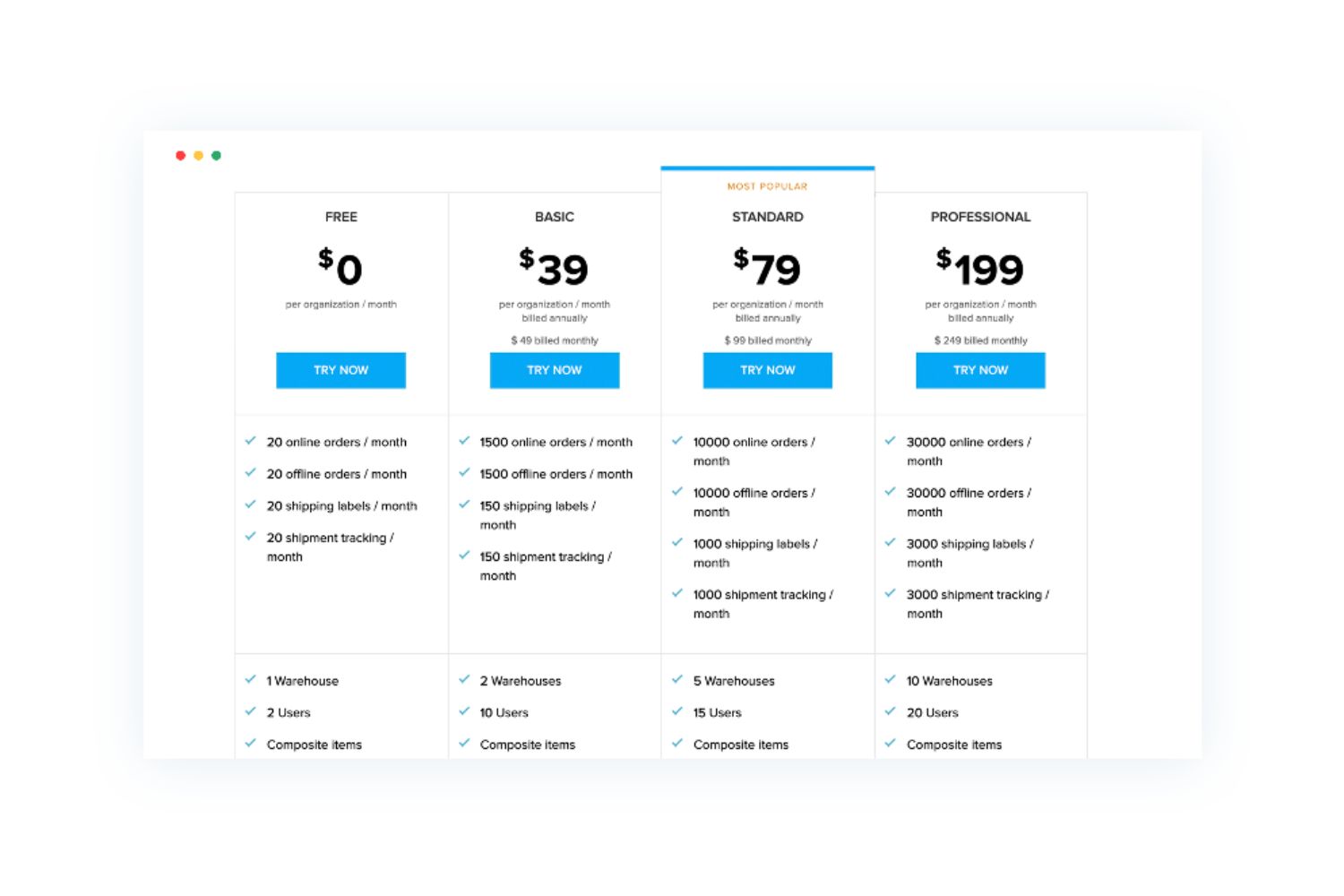Introduction
Welcome to the world of SaaS (Software as a Service) software pricing! Whether you’re a startup or an established company, getting your pricing strategy right is crucial for success in the competitive SaaS market. Pricing your SaaS software can be a complex task influenced by various factors such as your target audience, competition, and cost structure. In this article, we will guide you through the process of effectively pricing your SaaS software to maximize profitability and attract customers.
As you navigate the realm of SaaS software pricing, it’s essential to remember that pricing is not just about setting a number. It’s a strategic decision that requires careful consideration and analysis. Your pricing strategy should align with your business goals, target market, and the unique value proposition your software offers.
To craft an effective pricing strategy, it’s crucial to understand your target audience’s needs and preferences. Knowing their pain points and desired outcomes will help you determine the value your software delivers to them. Conduct market research, analyze customer feedback, and engage with your target audience to gain insights into their expectations and willingness to pay.
One of the key elements to consider in your pricing strategy is your unique value proposition. What sets your SaaS software apart from the competition? What value does it bring to your customers? Highlighting the features, benefits, and advantages of your software will allow you to differentiate yourself in the market and justify your pricing.
Another crucial aspect of pricing your SaaS software is determining your cost structure. Take into account factors such as development and maintenance costs, server expenses, customer support, and any additional operational overheads. Understanding your costs will help you set pricing that ensures profitability while remaining competitive.
When establishing your pricing strategy, it’s essential to assess your competition. Study their pricing models, features, and target markets. Understand how they position themselves in the market and analyze their customer base. This analysis will aid you in differentiating your pricing strategy and identifying opportunities for growth and improvement.
In the next sections, we will delve into various pricing models and strategies, such as the freemium model, subscription-based pricing, and usage-based pricing. We will discuss the advantages and potential pitfalls of each approach, helping you determine which model aligns best with your business objectives and target audience.
Setting the right price points is a critical step in your pricing strategy. You want to strike a balance between attracting customers with affordable pricing and generating sufficient revenue to sustain and grow your business. We will explore different pricing strategies, including value-based pricing and competitor-based pricing, to help you arrive at an optimal pricing structure.
Conducting pricing experiments can also be a valuable practice. By testing different price points, packages, and discount strategies, you can gather data and insights on customer behavior and preferences. This information will allow you to refine your pricing strategy and maximize your revenue potential.
Pricing tiers and plans are often a popular approach in SaaS software pricing. Offering different levels of features and functionality at various price points enables you to cater to a broader range of customers’ needs and budgets. We will provide guidance on how to create effective pricing tiers and plans that drive customer acquisition and retention.
Communicating your pricing effectively is key to gaining customer trust and confidence. Transparently conveying the value your software delivers, as well as the pricing structure, can help eliminate customer hesitations and objections. We will share tips and best practices on how to effectively communicate your pricing to your target audience.
Lastly, we will emphasize the importance of regularly reviewing and adjusting your pricing strategy as your business evolves. The SaaS market is dynamic, and customer expectations, competition, and cost structures can change over time. Monitoring market trends, analyzing customer feedback, and evaluating your financials will enable you to make data-driven pricing decisions.
By the end of this article, you will have a comprehensive understanding of the factors that influence SaaS software pricing and the strategies to implement for setting the right price for your product. Let’s dive in and unlock the potential of effective SaaS software pricing!
Understanding Your Target Audience
When it comes to pricing your SaaS software, understanding your target audience is key. Your target audience is the group of customers who are most likely to benefit from and purchase your software. By gaining a deep understanding of their needs, preferences, and pain points, you can tailor your pricing strategy to effectively attract and retain customers.
Start by conducting thorough market research to identify your target audience. Analyze demographic data, industry trends, and the characteristics of customers who have shown interest in similar software solutions. This research will give you insights into the specific segments of the market that are most likely to find value in your software.
Next, engage with your target audience directly. This can be done through surveys, interviews, or even hosting focus groups. By directly interacting with your potential customers, you can gain a deeper understanding of their challenges, goals, and preferences.
One effective approach is to create buyer personas, which are fictional representations of your ideal customers. These personas should encapsulate the characteristics, motivations, and pain points of different segments within your target audience. Having a clear picture of your buyer personas will help you develop a pricing strategy that resonates with their needs.
It’s also crucial to consider the different segments within your target audience and their willingness to pay. Some customers may prioritize affordability, while others are willing to invest more for additional features or premium support. By segmenting your target audience based on their willingness to pay, you can create pricing plans and tiers that cater to a wider range of customers.
Apart from understanding the needs and preferences of your target audience, it is vital to assess the value your software brings to them. What specific problems does your software solve? How does it improve their efficiency, productivity, or bottom line? By highlighting the benefits and unique value propositions of your software, you can justify your pricing and differentiate yourself from competitors.
Furthermore, consider the purchasing power and budget constraints of your target audience. Small businesses may have different financial capacities compared to larger enterprises. This knowledge will help you develop pricing plans that align with their budgets, ensuring that your software remains accessible and attractive.
Regularly monitoring and evaluating your target audience is critical as well. Market dynamics can change, and customer preferences can evolve over time. Stay up-to-date with market trends and competitive offerings. Leverage customer feedback to identify areas for improvement and evaluate the overall satisfaction with your pricing strategy.
Understanding your target audience empowers you to tailor your pricing strategy to effectively meet their needs and expectations. By continuously refining your understanding of your target audience, you can make smarter pricing decisions and position your SaaS software for success in the market.
Identifying Your Unique Value Proposition
In a crowded market, it’s vital to clearly communicate the unique value proposition of your SaaS software to potential customers. Your unique value proposition (UVP) is what sets your software apart from competitors and provides distinct advantages to your target audience.
Start by assessing the features, functionalities, and benefits of your software. What makes your software different from others in the market? Identify the problems your software solves or the pain points it addresses for your target audience. By addressing these pain points, you provide value and create a compelling reason for customers to choose your software.
Consider the specific industries or niches that your software caters to. Tailoring your UVP to meet the unique needs of these industries can be a powerful way to position your software as the go-to solution. Highlight how your software addresses industry-specific challenges or offers specialized features that competitors may not have.
One effective way to identify your unique value proposition is to conduct competitive research. Analyze your competitors’ offerings and identify any gaps or areas where you excel. Look for opportunities to differentiate yourself and emphasize those strengths in your pricing strategy.
Another aspect to consider when identifying your UVP is the user experience of your software. Does your software have a user-friendly interface? Are there any unique design elements that enhance usability? Customer satisfaction and ease of use can be strong selling points, so be sure to showcase these qualities in your pricing materials.
Customer testimonials and case studies can also contribute to your unique value proposition. Highlight success stories and testimonials from satisfied customers who have experienced the benefits of your software. This social proof can build trust and confidence among potential customers and make your software more compelling.
Lastly, keep in mind the scalability and flexibility of your software. Can it grow with the needs of your customers? Can it be customized to meet unique requirements? Emphasize the scalability and flexibility of your software as part of your UVP, especially if competitors have limited options in these areas.
By clearly identifying and effectively communicating your unique value proposition, you can differentiate your software from competitors and justify your pricing. Your UVP forms the foundation for your pricing strategy, offering customers a clear understanding of how your software can benefit them and why it’s worth the investment.
Determining Your Cost Structure
When pricing your SaaS software, understanding your cost structure is crucial. Determining your cost structure involves identifying the various expenses associated with developing, maintaining, and supporting your software. By knowing your costs, you can set prices that ensure profitability while remaining competitive in the market.
Start by identifying your development costs. This includes expenses related to software design, coding, and testing. Consider the resources, time, and expertise required to develop your software and factor in any external costs, such as outsourcing development or licensing third-party components.
In addition to development costs, consider the ongoing expenses of maintaining and supporting your software. This can include server costs, cloud hosting fees, software updates, security measures, and customer support. These costs are essential to provide a reliable and satisfactory user experience for your customers.
Other operational costs should also be taken into account. This may include marketing expenses, sales commissions, employee salaries, administrative costs, and any other overheads associated with running your SaaS business. These costs contribute to your overall cost structure and need to be covered by your pricing strategy.
It’s important to allocate costs accurately across your customer base. If you have different pricing plans or tiers, consider the resource utilization and support requirements associated with each plan. This ensures that your pricing accurately reflects the costs incurred by serving each customer segment.
Keep in mind the scalability of your business model. As your customer base grows, your costs may change. Assess how your costs will evolve with increased usage and customer growth, and incorporate this into your pricing strategy.
Understanding your cost structure goes beyond just knowing the numbers. It also involves evaluating the value your software provides to customers relative to the costs. Assess whether your pricing aligns with the perceived value of your software and whether it makes sense for customers to pay the proposed price for the benefits they receive.
Regularly review and update your cost structure as your business evolves. As you introduce new features or functionalities, there may be additional costs associated with their development and maintenance. Likewise, as your customer base and usage increase, your infrastructure and support expenses may change.
By determining your cost structure, you can set prices that not only cover your expenses but also generate a profit. Finding the right balance between value for customers and profitability for your business is crucial for long-term success in the SaaS market.
Assessing Your Competition
When pricing your SaaS software, it’s essential to assess your competition. Understanding your competitors and their pricing strategies allows you to position yourself strategically in the market and make informed pricing decisions that give you a competitive edge.
Start by identifying your direct competitors – those who offer similar software solutions to the same target audience. Research their offerings, features, and pricing models. Analyze their positioning in the market and determine what sets them apart from your software.
By studying your competitors, you can gain insights into their pricing strategies. Look for variations in their pricing plans, tiers, and features offered at different price points. Assess whether they use value-based pricing, freemium models, or other pricing methodologies. Understanding how competitors structure their pricing can provide valuable insights for your own pricing strategy.
Take note of any unique selling propositions (USPs) your competitors highlight. How do they differentiate themselves? Are there any gaps or areas where you excel in comparison? Identifying these USPs can help you understand your competitive advantages and leverage them in your pricing strategy.
Keep an eye on any pricing changes or promotions your competitors implement. Monitor how customers and the market respond to these changes. This information can help you gauge the effectiveness of different pricing approaches and guide your own pricing experiments.
It’s also beneficial to understand the customer base and target audience of your competitors. Analyze their customer reviews, ratings, and feedback. Identify any common pain points or areas of dissatisfaction that your software can address. By addressing these pain points, you can position your software as a more desirable alternative and justify your pricing.
While assessing your competition, it’s important to strike a balance between differentiation and staying competitive. You want to offer unique value to your customers, but you also need to be aware of the pricing expectations in your market. Conduct market research and gather data to determine the price range that is acceptable for your target audience.
Remember, the goal is not to necessarily match or undercut your competitors’ prices. Instead, aim to offer a package of value that justifies your pricing and attracts customers based on the benefits your software provides.
Assessing your competition is an ongoing process. The SaaS market is dynamic, and new competitors may emerge while existing ones may evolve their strategies. Continuously monitor the competitive landscape and stay informed to ensure that your pricing strategy remains relevant and effective.
By assessing your competition, you can gain valuable insights into pricing trends, customer expectations, and opportunities for differentiation. Utilize this information to position your SaaS software effectively and ensure that your pricing strategy is competitive in the market.
Pricing Models and Strategies
When it comes to pricing your SaaS software, you have a variety of pricing models and strategies to consider. Choosing the right approach can help maximize revenue, attract customers, and differentiate yourself from competitors. Let’s explore some common pricing models and strategies:
1. Freemium Model: In this model, you offer a basic version of your software for free, with limited features or functionality. Customers can then upgrade to a paid version to gain access to additional features or premium support. The freemium model can attract a large user base and allow customers to experience the value of your software before committing to a paid plan.
2. Subscription-based pricing: This is one of the most common pricing models in the SaaS industry. With subscription-based pricing, customers pay a recurring fee, typically on a monthly or annual basis, to access your software. This model provides predictable revenue and encourages customer loyalty through ongoing value delivery.
3. Usage-based pricing: With usage-based pricing, customers are billed based on their usage of your software, such as the number of users, data storage, or API calls. This model is suitable for products with variable or scalable usage, allowing customers to pay based on their specific needs and usage patterns.
4. Value-based pricing: In value-based pricing, the price is set based on the perceived value the software delivers to customers. This approach focuses on aligning the price with the value your software provides in solving customer problems or generating substantial benefits. Value-based pricing requires a deep understanding of customer needs and the ability to articulate and demonstrate the value proposition effectively.
5. Competitor-based pricing: In this strategy, you set your prices based on the prices of your competitors. By benchmarking against competitors, you can ensure that your pricing is competitive and aligned with market expectations. However, be cautious not to solely rely on competitor pricing as it may not consider your specific value proposition or cost structure.
6. Tiered pricing: Tiered pricing involves offering different pricing tiers that provide varying levels of features, functionalities, or support. This allows you to cater to different customer segments and their diverse needs and budgets. Tiered pricing helps maximize customer acquisition and retention by providing options that align with their specific requirements.
7. Dynamic pricing: Dynamic pricing involves adjusting prices based on various factors such as demand, seasonality, or customer segment. By leveraging data and analytics, you can optimize pricing to maximize revenue and respond to market fluctuations or changing customer preferences.
When selecting a pricing model or strategy, consider your target audience, competitor offerings, and the perceived value of your software. Experimentation and continuous evaluation of your pricing strategy are crucial to finding the right fit for your business and maximizing profitability.
It’s important to note that combining multiple pricing strategies or customizing pricing plans for specific customer segments may also be effective. Flexibility in your pricing approach allows you to cater to a wider range of customers and their unique requirements.
Remember, pricing is not a one-time decision but an ongoing process. Regularly monitor the market, assess customer feedback, and analyze your financials to make data-driven pricing adjustments and stay competitive in the ever-evolving SaaS landscape.
Setting the Right Price Points
Setting the right price points for your SaaS software is a crucial step in your pricing strategy. Pricing too high can discourage potential customers, while pricing too low may undervalue your software and hinder profitability. Here are some factors to consider when determining the right price points:
1. Value Proposition: The value your software delivers to customers should be a primary consideration. Assess the unique features, functionalities, and benefits your software provides compared to competitors. Set price points that align with the value your software offers and justify the investment for customers.
2. Market Research: Conduct market research to understand the pricing landscape in your industry. Analyze competitors’ pricing models, plans, and customer reviews. Identify any gaps or areas where your software provides superior value, allowing you to justify higher price points or offer more competitive pricing.
3. Customer Perception: Understand how your target audience perceives price and value. Consider their budget constraints, willingness to pay, and what they consider a fair price for the benefits your software provides. Survey your existing customers, conduct focus groups, and gather feedback to gauge customer perception of your pricing and make informed decisions.
4. Cost Structure: Take into account your cost structure, including development, maintenance, support, and operational costs. Your pricing should cover these expenses while still allowing for profitability. Evaluate how different price points align with your cost structure and ensure that they are financially sustainable in the long run.
5. Price Sensitivity: Assess the price sensitivity of your target audience. Some customers may prioritize cost-effectiveness, while others are willing to pay a premium for additional features or enhanced support. Consider offering different pricing tiers or plans to cater to different segments, allowing customers flexibility in finding a suitable price point.
6. Experimentation: Conduct pricing experiments to test different price points and packaging options. Monitor customer behavior, conversion rates, and revenue generation to gather data and insights. Adjust your pricing strategy based on the results to optimize your revenue potential.
7. Value-Based Upselling: Consider offering add-ons, upgrades, or premium features at higher price points to provide additional value and upsell opportunities. This allows customers to start at a lower price point and upgrade as they realize the value and benefits of your software.
8. Pricing Psychology: Leverage pricing psychology techniques, such as using tiered pricing or anchoring customers’ perception of value. Offer a clear distinction between pricing tiers, emphasizing the added benefits of higher-priced plans to justify their higher cost.
Remember, pricing is not a one-time decision. Continuously evaluate your pricing strategy based on customer feedback, market dynamics, and performance metrics. Regularly review and adjust your price points to ensure they remain competitive, relevant, and aligned with the evolving needs and expectations of your target audience.
Conducting Pricing Experiments
Conducting pricing experiments is a valuable practice when determining the optimal pricing strategy for your SaaS software. Pricing experiments allow you to gather data, test different price points, and make data-driven decisions to maximize your revenue potential. Here are some key considerations and strategies for conducting pricing experiments:
1. Define Clear Objectives: Before conducting pricing experiments, clearly define your objectives. It could be to measure the impact of different price points on conversion rates, evaluate customer willingness to pay, or assess the profitability of new pricing tiers. Setting clear objectives will guide your experimentation process and ensure meaningful results.
2. Test Small Segments: Start by testing different price points on small segments of your target audience. This minimizes the risk and allows you to gather feedback and insights before implementing changes at a larger scale. Divide your customers into different segments and randomly assign them to different pricing variations.
3. Monitor Key Metrics: Track and analyze key metrics during your pricing experiments. Conversion rates, customer acquisition cost, revenue per customer, and customer churn are some of the essential metrics to monitor. Compare the performance of different price points to understand the impact on these metrics and determine which pricing strategy yields the most favorable results.
4. Measure Customer Value Perception: Use customer surveys, interviews, or focus groups to gather feedback on their perception of value at different price points. Understand how customers perceive the benefits, features, and pricing of each variation. This qualitative data can provide valuable insights into customer preferences and help refine your pricing strategy.
5. A/B Testing: A/B testing is a common approach in pricing experiments. Randomly split your audience into two groups – one group experiences the current pricing while the other group sees a new pricing variation. Compare the performance metrics between the two groups to determine the impact of the pricing change.
6. Analyze Competitor Pricing: Consider including competitor pricing in your experiments. Test how your potential customers respond to different price differentials compared to your competitors. This can help you determine the price range that is acceptable to customers and identify opportunities for differentiation.
7. Iterate and Learn: Pricing experiments are an iterative process. Analyze the results, gather insights, and make adjustments based on the findings. Continuously refine your pricing strategy based on customer feedback, market dynamics, and the data from the pricing experiments.
8. Consider Long-Term Impacts: Keep in mind that pricing experiments are not only about short-term revenue gains. Consider the long-term impacts on customer acquisition, customer satisfaction, and customer retention. Strive for a pricing strategy that not only maximizes immediate revenue but also builds a sustainable and profitable customer base.
Pricing experiments provide valuable insights that help you make informed decisions about your pricing strategy. By testing different price points, packages, or pricing models, you can refine your pricing to align with customer expectations, increase conversion rates, and optimize revenue generation.
Pricing Tiers and Plans
Offering pricing tiers and plans is a popular approach in SaaS software pricing. This strategy allows you to cater to a wider range of customer needs and budgets, providing flexibility and options. Here are some key considerations when designing pricing tiers and plans:
1. Understand Customer Segments: Divide your target audience into different customer segments based on their needs, preferences, and willingness to pay. Assess the unique characteristics and requirements of each segment to create pricing tiers that cater to their specific needs.
2. Feature Differentiation: Differentiate your pricing tiers based on the features, functionalities, and performance levels that customers receive at each level. Ensure that the value proposition of each tier is compelling and justifies the price difference. Highlight the additional benefits and advantages that customers gain by choosing higher-priced plans.
3. Scalability and Usage Limits: Consider including usage limits or scalability options in your pricing tiers. This allows customers to choose a plan that aligns with their usage needs and ensures that they pay for the value they receive. Clearly communicate the thresholds and any overage charges associated with exceeding usage limits.
4. Pricing Psychology: Utilize pricing psychology techniques to influence customers’ perception of value. Position your mid-tier plan as the most attractive option by pricing it slightly lower than the highest tier but offering a compelling set of features. This creates a sense of value and encourages customers to upgrade from the entry-level plan.
5. Trial and Promo Periods: Consider offering trial periods or promotional discounts to encourage customers to explore the benefits of higher-priced plans. These incentives can help customers experience the value of your software and feel confident in upgrading to a more feature-rich plan after the trial period ends.
6. Clear Plan Differentiation: Clearly communicate the differences between your pricing tiers. Use clear and concise descriptions to outline the features and benefits of each plan. Avoid overwhelming customers with too much information, but provide enough details for them to make an informed decision.
7. Customer Feedback and Iteration: Regularly gather feedback from your customers regarding your pricing tiers and plans. Understand their preferences, pain points, and any desired features that may influence their upgrade decisions. Use this feedback to iterate and refine your pricing structure to better align with customer needs.
8. Consider Customized Plans: For larger enterprise clients or customers with unique needs, offer the option for customized pricing plans. This allows you to tailor a plan that fits their specific requirements and budget, increasing the likelihood of securing their business and building long-term relationships.
9. Evaluate Competitor Plans: Assess the pricing tiers and plans offered by your competitors. Understand how they differentiate their plans and the value they provide at each price point. This analysis can help you identify opportunities for differentiation and ensure that your pricing remains competitive in the market.
Pricing tiers and plans provide customers with options and allow you to capture a broader customer base. By carefully designing your pricing structure, clearly communicating the value of each tier, and continually evaluating customer feedback, you can optimize your revenue potential and cater to the diverse needs of your target audience.
Communicating Your Pricing Effectively
Effectively communicating your pricing is essential to gain customer trust, eliminate hesitations, and drive conversions. Here are some key strategies to communicate your pricing effectively:
1. Transparent and Clear Communication: Be transparent about your pricing. Clearly communicate the value customers will receive at each price point and the features and benefits included in each plan. Use simple and concise language to avoid confusion and ensure that customers understand what they are paying for.
2. Highlight the Value Proposition: Emphasize the value your software provides at the proposed price points. Clearly articulate the problems it solves, the benefits it offers, and the impact it can have on customers’ businesses. Show how the pricing aligns with the value they will receive, making it more compelling and justifiable.
3. Pricing Page Design: Design your pricing page in a visually appealing and user-friendly manner. Use clear headings, bullet points, and concise descriptions to present information. Include comparison tables that outline the features and benefits of each pricing tier, making it easy for customers to compare and make an informed decision.
4. Answer FAQs: Anticipate and address common questions or concerns that customers may have about your pricing. Create an FAQ section on your website to provide clear answers to questions related to pricing, such as billing cycles, discounts, and cancellation policies. This helps alleviate any doubts and provides transparency.
5. Provide Customer Testimonials: Featuring customer testimonials that highlight the value they receive from your software can help build trust and credibility. Include testimonials that specifically mention the pricing and the benefits that customers have experienced at different pricing tiers.
6. Offer a Free Trial or Demo: If feasible, consider offering a free trial or demo of your software. This allows potential customers to experience the value firsthand and helps them understand the features and benefits before making a purchasing decision. Clearly communicate the pricing details during the trial or demo period, so customers have a full understanding of what they will be paying for after the trial ends.
7. Provide Multiple Contact Channels: Make it easy for potential customers to reach out for any pricing-related inquiries. Offer multiple contact channels, such as live chat, email, or phone support, to provide prompt and personalized assistance. Respond to pricing questions promptly and ensure your customer support team is knowledgeable about your pricing structure.
8. Offer Pricing Guarantees or Money-Back Policies: Consider offering pricing guarantees or money-back policies to alleviate customer concerns and reduce risk. This can provide reassurance to customers that they will receive the value promised or have the option to seek a refund if they are not satisfied.
9. Regularly Evaluate and Adjust: Continuously monitor customer feedback, market trends, and competitive pricing strategies. Regularly evaluate and adjust your pricing communication based on this information. Stay responsive to customer needs and make updates to your messaging or packaging to ensure continued effectiveness.
By effectively communicating your pricing, you can enhance customer understanding, build trust, and increase the likelihood of conversions. Remember to maintain transparency, highlight the value proposition, and provide clear and comprehensive information to help customers make informed decisions about your pricing plans.
Regularly Reviewing and Adjusting Your Pricing Strategy
Regularly reviewing and adjusting your pricing strategy is essential in the ever-evolving world of SaaS software. Market dynamics, customer expectations, and competitive landscapes can change over time, requiring you to stay vigilant and adaptable. Here are some reasons why regular pricing strategy reviews and adjustments are crucial:
1. Stay Competitive: Regularly review your pricing strategy to ensure that it remains competitive in the market. Assess the pricing strategies employed by your competitors and consider any changes or new offerings they introduce. Stay informed about new market entrants and innovations that could impact your pricing. Adjust your pricing strategy as needed to maintain a competitive edge.
2. Reflect Value and Costs: As your software evolves and new features or enhancements are introduced, your pricing should reflect the additional value provided. Assess the value proposition of your software and determine if any adjustments are needed to ensure that the price aligns with the benefits customers receive. Additionally, evaluate any changes in your cost structure and adjust your pricing if necessary to maintain profitability.
3. Customer Feedback and Market Trends: Continuously gather and evaluate customer feedback to identify pain points, areas for improvement, and opportunities for pricing adjustments. Listen to your customers’ needs and understand their evolving expectations. Additionally, monitor market trends and industry benchmarks to stay informed about prevailing pricing norms and customer preferences. Use this feedback and market insights to make informed pricing decisions.
4. Pricing Experiments and Testing: Regularly conduct pricing experiments and testing to gather data and insights on customer behavior, revenue generation, and customer satisfaction. Analyze the results and make adjustments to your pricing strategy based on the findings. Experimentation allows you to optimize your pricing structure and identify the most effective price points and packaging options.
5. Retain Existing Customers: Regularly evaluating and adjusting your pricing strategy can help retain existing customers. Understand their changing needs, usage patterns, and budget constraints. Consider offering loyalty discounts, incentives, or personalized pricing plans to show appreciation and maintain customer loyalty. This proactive approach can help reduce customer churn and improve customer retention rates.
6. Acquire New Customers: Adjusting your pricing strategy can also help attract new customers. Conduct market research and identify emerging customer segments or market niches that could benefit from your software. Adapt your pricing plans or packaging options to target these specific segments effectively. Consider offering introductory discounts or limited-time promotions to incentivize new customers to choose your software over competitors.
7. Monitor Financial Performance: Regularly monitor and analyze the financial performance of your pricing strategy. Assess revenue, customer acquisition costs, and profitability metrics. Evaluate the impact of any pricing changes or adjustments on these financial indicators. Make data-driven decisions to optimize revenue and ensure the long-term financial health of your SaaS business.
8. Communicate Pricing Changes: When making adjustments to your pricing strategy, communicate these changes clearly to your existing and potential customers. Clearly explain the reasons for the adjustments and the value they will receive at the new price points. Provide ample notice of any price increases and consider offering grandfathering options for existing customers to maintain their current pricing for a specific period.
Regularly reviewing and adjusting your pricing strategy is crucial to staying competitive, ensuring profitability, and meeting customer needs. By embracing a proactive and data-driven approach to pricing, you can continually refine your pricing strategy to maximize revenue, improve customer satisfaction, and drive business growth.
Conclusion
Pricing your SaaS software is a critical aspect of your business strategy that requires careful consideration and ongoing attention. By understanding your target audience, identifying your unique value proposition, determining your cost structure, assessing your competition, and implementing effective pricing models and strategies, you can set the right price points for your software.
Conducting pricing experiments, creating pricing tiers and plans, and communicating your pricing effectively are all important elements in refining your pricing strategy. Regularly reviewing and adjusting your pricing is necessary to stay competitive, reflect value and costs, and respond to customer feedback and market trends. This iterative process helps you acquire new customers, retain existing customers, and optimize your revenue potential.
Remember that pricing is not a one-size-fits-all approach and requires flexibility and adaptability. Stay responsive to changes in the market, customer preferences, and industry benchmarks. Continuously gather data, evaluate customer feedback, and monitor financial performance to make informed pricing decisions.
As you navigate the intricate world of SaaS software pricing, it’s essential to strike a balance between generating profitability for your business and delivering value to your customers. Align your pricing strategy with your business goals, target audience, and the unique value your software offers. Regularly evaluate and iterate to ensure that your pricing remains competitive, sustainable, and aligned with the evolving needs of your customers.
By implementing effective pricing strategies and regularly reviewing and adjusting your pricing, you can position your SaaS software for success in the competitive market and drive both customer acquisition and long-term customer loyalty.

























